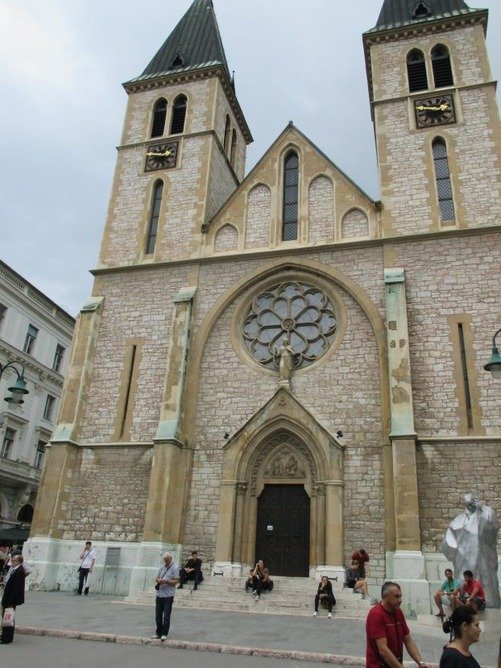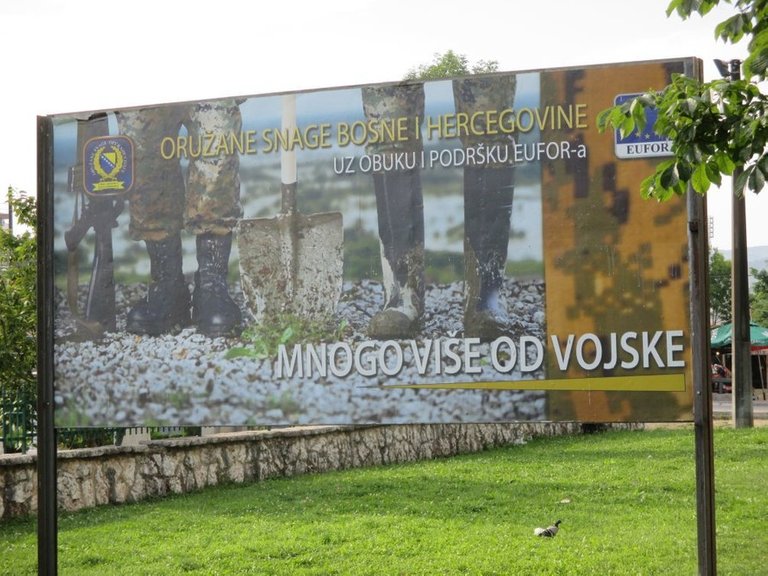Welcome back to the tour! In Part III of our Yugoslavian Adventure Series, we visited an interesting exhibition about the siege of Sarajevo in the Historical Museum of Bosnia and Hercegovina and went up to the Zmajevac – a high hill from which we enjoyed an amazing bird's eye view upon the city.
Today, we will visit Sarajevo's religious landmarks – let's go!
Sarajevo's Religious Heritage
In Part I and Part II we visited the many Ottoman mosques of Sarajevo. As a consequence of the Bosnian War, nowadays the city's population is predominantly Sunni-Muslim. However, historically it used to be very religiously diverse due to its troubled history and geographical location at the crossroad of many Empires.
Sarajevo still advertises itself with its old nickname – Jerusalem of Europe – and the other major faiths, which are still practised by local communities, include Orthodox Christianity, Catholicism, Protestantism, and Judaism.
The Serbian Orthodox Cathedral of Sarajevo is one of the largest Christian Churches in the Balkans.
The Cathedral Church of the Nativity of the Theotokos is a 19th century baroque structure not far from the Old Town and its beautiful Ottoman mosques. It was financed by the Serbian merchants of the town while the city was still part of the Ottoman Empire. Interestingly, although its construction caused some turmoil among Sarajevo's native Muslim population due to its height and imposing architecture, the Ottoman Sultan let the construction site be protected by police against conservative Muslim protesters.
Interior room and iconostasis. Icons are venerated by Orthodox Christians as living images of Christ and the Saints, not mere artistic representations.
Also, the cathedral's iconostasis was craftet by Russian artisans sent by Tsar Alexander II as a brotherly gesture to the Serbians. This is quite remarkable, since the Ottoman and the Russian Empire have always been major geopolitical rivals. It was the proclaimed Russian goal in many of the Russo-Turkish wars to liberate the Orthodox Balkan Slavs from Ottoman rule.
The statue to the right of this Catholic Cathedral represents Pope John Paul II, who visited Sarajevo in 1997 – shortly after the war – to preach forgiveness.
The 19th century, neo-gothic Sacred Heart Cathedral is the center of Catholicism in Bosnia and is considered to be one of the city's most iconic landmarks. Unfortunately, it was closed when I visited Sarajevo, so I have no pictures of the interior (but you can google for them). In the Balkans, Catholicism is mainly practiced by Croatians and it used to play a prominent role in Bosnia while it was part of the Austro-Hungarian Empire.
This interestingly looking building is not a church at all. But it used to be one.
What you see here is Sarajevo's Academy of Fine Arts, which hosted a wonderful street exhibition of photographs from war zones all aroud the world while I visited. A nice place in its own merit, yet it wasn't originally intended to be an academy.
This wonderful baroque structure was built at the very end of the 19th century (1899) by Austrian architect Filip Balif and Czech architect Karl Paržik and served as a cathedral for the city's (mainly German) Protestant community. Most Protestants left Sarajevo by the end of the First World War, which also prominently began here when Serbian revolutionary Gavrilo Princip assassinated the Archduke of Austria on June 28th, 1914.
It became the Academy of Fine Arts in 1970, when the last remaining Protestants handed the building over to the Yugoslavian government.
Groblje Lav
I suggest that we should visit another place of religious significance now, which is the Sarajevo's Lion Cemetery, known by this name for its prominent lion statue you see above.
The graves here are as religiously and culturally diverse as the churches. Here you see the Serbian-Orthodox section of the graveyard. I suppose this small building is a crypta.
One of the many Serbian gravestones.
Right next to the Serbian section lies the Catholic section, which is marked by a statue of Jesus on a cross.
A German grave. It is now exactly a century old.
The Jesus statue in closer detail. It is a beautiful work of art, in my humble opinion.
Finally, the most prominent section of the graveyard is the Muslim one, which is marked by a huge structure which looks like either a minaret or a space rocket. I don't want to be disrespectful, but it reminded me of the Space Needle in Moscow. I don't know the significance of it, but most of the graves in this section are fresher than the other ones, because there are many Bosnian victims of the war buried here. Soldiers and civilians alike. Overall, the territory of the cemetary is huge and you can walk it for miles and miles, wondering about the personal histories of the thousands of people who rest here.
I have to say that I found it a bit kafkaesque that this recruitement poster for the Bosnian armed forces is right next to the war graves.
TO BE CONTINUED
And that's it for today! Our stay in Bosnia will be longer than I expected, because I always end up writing more about my photos than I think! I hope you enjoy these blogs, because in Part V we are going to see some random sights and interesting places around the city and we are going to take a cab to the Vrelo Bosne – a beautiful natural enclosure and mountain spring. If you like my content, please follow me and resteem it! :)














I really dig the architectural design of the homes there in Sarajevo. Nice Pictures.
Wow Sarajevo looks really interesting, love diversity in the architecture, look forward to more post from you !
Thanks, there will be a lot more to come. This series will be a long one. :)
Hey Temnozor, make sure to visit the abandoned bobsleigh track near Sarajevo!
It's such a surreal place to be. It's around a nice two hour uphill hike from the city centre.
Thanks for the tip, I'll look for it if I visit the city again! Is it part of the Olympic installations?
Yes, a huge structure and completely abandoned now. Now it's like an open air graffiti museum.
Awesome, too bad that I missed it. I love abandoned stuff.
Bosnia and Herzegovina in general has a lot of abandoned stuff due to the war as you've probably noticed.
I've been there recently and I think I might as well make a post about some abandoned structures I've visited there.
Oh yeah, whole houses and factories. I noticed most of it while I was driving through the countryside. There are whole bombed out villages that have been overgrown by small forests. It reminded me a bit of Eastern Germany in the 90s, which was a paradise for any URBEX ethusiast (though I was a child at the time).
However, I didn't stray too far from the main touristic routes while I was there. It was an unplaned individual trip from my first student money, I'm perfectly aware that I missed a lot. Just the more reason to revisit, though. :)
Congratulations @temnozor! You have completed some achievement on Steemit and have been rewarded with new badge(s) :
Click on any badge to view your own Board of Honor on SteemitBoard.
For more information about SteemitBoard, click here
If you no longer want to receive notifications, reply to this comment with the word
STOP